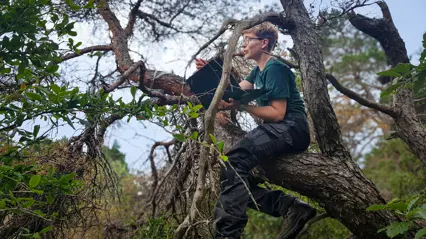News
-
Pollution and drought disrupt soil microbes that support crops
Laura J. Müller’s doctoral thesis shows how pollution and drought disrupt the soil microbes that control nitrogen cycling. Combined stressors can weaken these hidden ecosystems, threatening both crop growth and environmental health. -
Beneath the pines: how fungi drive forest nutrient cycles
In her new doctoral thesis, Katharine King shows how ectomycorrhizal fungi drive nutrient cycling in the forest by linking mineral weathering and nitrogen mobilisation, which supports tree growth and keeps the ecosystem healthy. -
SLU and the forest sector in new collaboration to train future experts
SLU is now announcing eight new PhD positions as part of a collaboration with the forest sector. The positions are part of the research programme Wallenberg Initiatives in Forest Research (WIFORCE), aimed at meeting future knowledge needs for the sustainable management and conservation of forests.

Agriculture and forestry in a changing world
Through our research we answer questions about how agriculture and forestry can be conducted in a world where the climate is changing. We conduct both basic and applied research and have active collaborations with forestry and agriculture.

Undergraduate education
From fungi and lichens to forest ecology, forest and agricultural pathogens and biogeochemical cycles. Find our courses, distance courses and independent work here.

Doctoral education BK
Are you interested in learning about and developing new knowledge for more sustainable agriculture and forestry? Our doctoral program provides a scientific approach, subject knowledge, and training in pedagogy and leadership.
About us
You can find us out in the field digging holes with big shovels or pipetting like there is no tomorrow in the lab. We investigate how microorganisms like fungi and bacteria interact with the environment. The Department is part of Biocentrum Ultuna at SLU in Uppsala.
Collaboration
Collaboration and continuous dialogue with stakeholders and the public is the foundation for our research. Our field pathologist and forest and tree mycologist are always in dialogue with the surrounding community.
For staff
Find internal information about where to book trips, rooms and equipment or get on the computing grid.
Research
Research projects
-
The role of Swedish mountain birch forests in preserving insects and fungi
What role do mountain birch forests play in preserving species that live in and on dead wood and are disadvantaged by forestry? In this project, researchers are seeking answers by mapping which wood-dwelling insects and fungi live in mountain birch forests. -
Ecological restoration of boreal low-productive pine forests
The project aim to assess the potential of ecological restoration of low-productive pine forests for the conservation of biodiversity associated with Scots pine. -
Thresholds and tipping points in ecosystem responses to global warming
Thresholds and tipping points in ecosystem responses to global warming, THRESHOLD, uses a novel cross-disciplinary approach to advance our fundamental knowledge of how non-linear temperature responses transcend different levels of ecological organization. -
SOB4ES
SOB4ES is a large project with 19 partners on a mission to make soil biodiversity visible to society and integrate it into EU policies. Within SOB4ES, we analyze soil biodiversity under various intensities of major land uses in pedoclimatic regions representative for the EU. -
Mycorrhizal symbiosis
We focus on the biology, evolution and ecology of symbiotic mycorrhizal fungi. Our research includes the diversity and molecular evolution of symbiotic fungi and their roles in biogeochemical cycling, mineral weathering and carbon sequestration.
Research groups
-
Agricultural Plant Pathology
We conduct research within plant pathology and plant-microbe interactions with relevance for plant health. This includes pathogenic interactions in agricultural systems, but also beneficial interactions used for biological disease control and plant growth promotion. -
Forest microbiology
We focus on the role of soil biota in plant performance and ecosystem functioning. -
Forest Pathology
Our research in forest pathology concentrates on pathogenic fungi causing diseases in forests. We study the interactions between the pathogen, the host tree and the environment from molecular to ecosystem level. -
Plant disease epidemiology
Diseases in crops result in economic losses and account for a significant proportion of pesticide use in agriculture. We study the epidemiology of plant diseases to inform and support the implementation of sustainable management strategies. -
Soil Microbiology
Microorganisms play a key role in nature’s cycles, controlling how essential nutrients like nitrogen move through ecosystems. By understanding their functions, we can find solutions to environmental challenges such as eutrophication, climate change, and unsustainable agriculture.